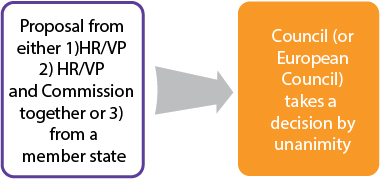Decision making in common foreign and security policy
The rules for decision making in matters of common foreign and security policy are quite different from the policy making procedures we have discussed above.
The major distinctions lie in a) the right of initiative, b) the decision making in the Council and c) the role of the Parliament and Commission that is much weaker under CFSP.
The right of initiative
We noted above the one of the key rights of the Commission was the right of initiative. However, in matters of CFSP, both the EU High Representative for Foreign Affairs and Security Policy/Vice President (HR/VP) – currently Federica Mogherini – and EU member states have the right to initiate policy, not the Commission. The Commission is able to initiate a joint-proposal with the High Representative, but not by itself.
To this effect, Article 22.1 of the TEU states that –
“Any Member State, the High Representative of the Union for Foreign Affairs and Security Policy, or the High Representative with the Commission’s support, may refer any question relating to the common foreign and security policy to the Council and may submit to it, respectively, initiatives or proposals”
Note the Commission’s limited role.
Decisions
Decisions under CFSP are almost exclusively taken by unanimity.
Article 24 of the TEU clearly states that –
“The common foreign and security policy is subject to specific rules and procedures. It shall be defined and implemented by the European Council and the Council acting unanimously, except where the Treaties provide otherwise”
There are some exceptions, however.
In certain areas, states can constructively abstain, which means states are not obliged to apply decisions taken, but will allow the decision to be adopted. However, if one third of member states decide to constructively abstain, the decision will not be passed.
Likewise, the European Council can request for a decision to be taken under QMV, but the decision to request this must be taken by unanimity.
Some technical decisions regarding the European Defence Agency and EDSP can be taken under QMV in the Council. However, any member state can apply a “brake” to any QMV decision, where the High Representative will have to try to find an acceptable solution. If they cannot, then member states can vote by QMV to have the issue referred to the European Council for a decision to be voted on unanimously.
The more straightforward and less supranational procedure under CFSP…

The Commission and the Parliament
As mentioned above, the Commission and the Parliament have significantly reduced powers under CFSP than in all other policy areas.
The Parliament may ask questions to the Council and the High Representative and make recommendations but these can be ignored. The Parliament does have some power but only through its control over the EU budget.
The Commission, as mentioned above, does not have the right of initiative under the CFSP, although it does retain some influence through the High Representative’s double role as HR and Vice President of the Commission.
Legal instruments
Under the former Treaty of the European Union, CFSP legal instruments could take five forms: principles and general guidelines, common strategies, joint actions, common positions or decisions.
These have (since Lisbon) been replaced with one instrument, decisions, that incorporates all of the above and outlines the actions that states are supposed to take. As before Lisbon, there is no mechanism for the Commission to monitor the implementation of CFSP decisions and the ECJ has no jurisdiction to condemn or imposes any penalties on member states for non-implementation.
Calendar
| M | T | W | T | F | S | S |
|---|---|---|---|---|---|---|
| 1 | 2 | 3 | 4 | 5 | 6 | 7 |
| 8 | 9 | 10 | 11 | 12 | 13 | 14 |
| 15 | 16 | 17 | 18 | 19 | 20 | 21 |
| 22 | 23 | 24 | 25 | 26 | 27 | 28 |
| 29 | 30 | 31 | ||||
Leave a Reply